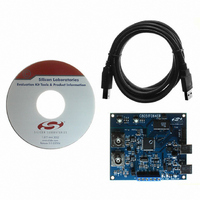C8051F064EK Silicon Laboratories Inc, C8051F064EK Datasheet - Page 173

C8051F064EK
Manufacturer Part Number
C8051F064EK
Description
KIT EVAL FOR C8051F064
Manufacturer
Silicon Laboratories Inc
Type
MCUr
Specifications of C8051F064EK
Contents
Evaluation Board, Power Supply, USB Cables, Adapter and Documentation
Processor To Be Evaluated
C8051F06x
Interface Type
USB
Silicon Manufacturer
Silicon Labs
Core Architecture
8051
Silicon Core Number
C8051F064
Silicon Family Name
C8051F06x
Lead Free Status / RoHS Status
Contains lead / RoHS non-compliant
For Use With/related Products
C8051F064
Lead Free Status / Rohs Status
Lead free / RoHS Compliant
Other names
336-1219
- Current page: 173 of 328
- Download datasheet (2Mb)
15.2. External Oscillator Drive Circuit
The external oscillator circuit may drive an external crystal, ceramic resonator, capacitor, or RC network. A
CMOS clock may also provide a clock input. For a crystal or ceramic resonator configuration, the crystal/
resonator must be wired across the XTAL1 and XTAL2 pins as shown in Option 1 of Figure 15.1. In RC,
capacitor, or CMOS clock configuration, the clock source should be wired to the XTAL2 and/or XTAL1
pin(s) as shown in Option 2, 3, or 4 of Figure 15.1. The type of external oscillator must be selected in the
OSCXCN register, and the frequency control bits (XFCN) must be selected appropriately (see
Figure 15.5).
15.3. System Clock Selection
The CLKSL bit in register CLKSEL selects which oscillator generates the system clock. CLKSL must be
set to ‘1’ for the system clock to run from the external oscillator; however the external oscillator may still
clock peripherals (timers, PCA) when the internal oscillator is selected as the system clock. The system
clock may be switched on-the-fly between the internal and external oscillator, so long as the selected oscil-
lator is enabled and settled. The internal oscillator requires little start-up time, and may be enabled and
selected as the system clock in the same write to OSCICN. External crystals and ceramic resonators typi-
cally require a start-up time before they are settled and ready for use as the system clock. The Crystal
Valid Flag (XTLVLD in register OSCXCN) is set to ‘1’ by hardware when the external oscillator is settled. To
avoid reading a false XTLVLD, in crystal mode software should delay at least 1 ms between enabling the
external oscillator and checking XTLVLD. RC and C modes typically require no startup time.
-40°C to +85°C unles otherwise specified.
Calibrated Internal Oscillator
Frequency
Internal Oscillator Supply
Current (3.0V Supply)
Bits7-1:
Bit0:
R/W
Bit7
-
Parameter
Reserved.
CLKSL: System Clock Source Select Bit.
0: SYSCLK derived from the Internal Oscillator, and scaled as per the IFCN bits in OSCICN.
1: SYSCLK derived from the External Oscillator circuit.
R/W
Bit6
-
Figure 15.4. CLKSEL: Oscillator Clock Selection Register
Table 15.1. Internal Oscillator Electrical Characteristics
R/W
Bit5
-
OSCICN.7 = 1
R/W
Bit4
-
Conditions
Rev. 1.2
R/W
Bit3
-
C8051F060/1/2/3/4/5/6/7
R/W
Bit2
-
Min
24
R/W
Bit1
-
24.5
Typ
550
SFR Address:
CLKSL
SFR Page:
Max
R/W
Bit0
25
0x97
F
Reset Value
00000000
Units
MHz
µA
173
Related parts for C8051F064EK
Image
Part Number
Description
Manufacturer
Datasheet
Request
R
Part Number:
Description:
SMD/C°/SINGLE-ENDED OUTPUT SILICON OSCILLATOR
Manufacturer:
Silicon Laboratories Inc
Part Number:
Description:
Manufacturer:
Silicon Laboratories Inc
Datasheet:
Part Number:
Description:
N/A N/A/SI4010 AES KEYFOB DEMO WITH LCD RX
Manufacturer:
Silicon Laboratories Inc
Datasheet:
Part Number:
Description:
N/A N/A/SI4010 SIMPLIFIED KEY FOB DEMO WITH LED RX
Manufacturer:
Silicon Laboratories Inc
Datasheet:
Part Number:
Description:
N/A/-40 TO 85 OC/EZLINK MODULE; F930/4432 HIGH BAND (REV E/B1)
Manufacturer:
Silicon Laboratories Inc
Part Number:
Description:
EZLink Module; F930/4432 Low Band (rev e/B1)
Manufacturer:
Silicon Laboratories Inc
Part Number:
Description:
I°/4460 10 DBM RADIO TEST CARD 434 MHZ
Manufacturer:
Silicon Laboratories Inc
Part Number:
Description:
I°/4461 14 DBM RADIO TEST CARD 868 MHZ
Manufacturer:
Silicon Laboratories Inc
Part Number:
Description:
I°/4463 20 DBM RFSWITCH RADIO TEST CARD 460 MHZ
Manufacturer:
Silicon Laboratories Inc
Part Number:
Description:
I°/4463 20 DBM RADIO TEST CARD 868 MHZ
Manufacturer:
Silicon Laboratories Inc
Part Number:
Description:
I°/4463 27 DBM RADIO TEST CARD 868 MHZ
Manufacturer:
Silicon Laboratories Inc
Part Number:
Description:
I°/4463 SKYWORKS 30 DBM RADIO TEST CARD 915 MHZ
Manufacturer:
Silicon Laboratories Inc
Part Number:
Description:
N/A N/A/-40 TO 85 OC/4463 RFMD 30 DBM RADIO TEST CARD 915 MHZ
Manufacturer:
Silicon Laboratories Inc
Part Number:
Description:
I°/4463 20 DBM RADIO TEST CARD 169 MHZ
Manufacturer:
Silicon Laboratories Inc










